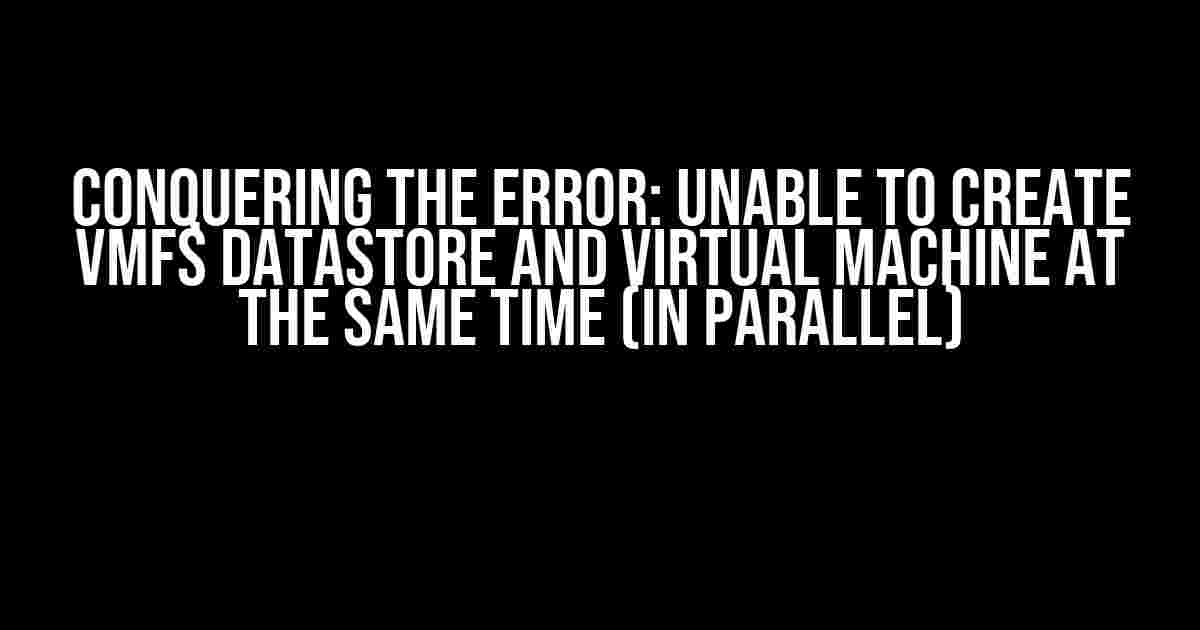Are you stuck with the frustrating error message “Unable to create VMFS datastore and virtual machine at the same time (in parallel)”? Don’t worry, you’re not alone! This article is here to guide you through the potential causes, solutions, and best practices to overcome this hurdle and get your virtual machine up and running smoothly.
Understanding the Error
The error message “Unable to create VMFS datastore and virtual machine at the same time (in parallel)” typically occurs when you’re attempting to create a new virtual machine and a VMFS datastore simultaneously. This error is often seen in vSphere environments, particularly when using vCenter Server or ESXi hosts.
Possible Causes
Before we dive into the solutions, let’s explore some possible reasons behind this error:
- Inadequate permissions or access control
- Insufficient resources (CPU, RAM, or storage)
- Conflicting configurations or settings
- Network connectivity issues
- _bug_ or software glitches
Solutions and Workarounds
Now, let’s get to the good stuff! Here are some solutions and workarounds to help you overcome the “Unable to create VMFS datastore and virtual machine at the same time (in parallel)” error:
1. Create the VMFS Datastore First
Try creating the VMFS datastore before creating the virtual machine. This approach ensures that the datastore is available and ready for use when you create the virtual machine.
# Create a new VMFS datastore
esxcli storage vmfs add -l -s
# Create a new virtual machine
vim-cmd vmsvc/getallvms
vim-cmd vmsvc/createsnapshot ""
2. Use a Different Order of Operations
Reverse the order of operations: create the virtual machine first, and then add the VMFS datastore to the virtual machine.
# Create a new virtual machine
vim-cmd vmsvc/getallvms
vim-cmd vmsvc/createsnapshot ""
# Add the VMFS datastore to the virtual machine
esxcli storage vmfs add -l -s -m
3. Verify Permissions and Access Control
Check that you have the necessary permissions and access control to create both the VMFS datastore and virtual machine. Ensure that your user account has the required privileges and roles.
| Privilege | Description |
|---|---|
| VirtualMachine.Config.AddNewDisk | Required to create a new virtual machine |
| Datastore.AllocateSpace | Required to create a new VMFS datastore |
4. Check Resource Availability
Verify that you have sufficient resources (CPU, RAM, and storage) available to create both the VMFS datastore and virtual machine.
# Check available resources
esxcli hardware cpu list
esxcli hardware memory list
esxcli storage filesystem list
5. Resolve Network Connectivity Issues
Ensure that your network connections are stable and configured correctly. Check for any issues with DNS resolution, NTP synchronization, or network segmentation.
# Check network connectivity
ping
ping
6. Update Your vSphere Environment
Make sure your vSphere environment is up-to-date with the latest patches and updates. This can help resolve any software-related issues.
# Update your vSphere environment
esxcli software vib update --depot=https://hostupdate.vmware.com/software/VUM/VOSSA/VUM-7.0.3-17327517-ESXi680-VMW-depot.zip
Bonus Tips and Best Practices
To avoid this error altogether, consider the following tips and best practices:
Tip 1: Plan Ahead
Before creating a new virtual machine, ensure that you have sufficient resources available and plan your configuration accordingly.
Tip 2: Use Automation Tools
Consider using automation tools like PowerCLI, vRealize Orchestrator, or Ansible to simplify and streamline your virtual machine and VMFS datastore creation process.
Tip 3: Monitor Your Environment
Regularly monitor your vSphere environment for any issues or errors. This can help you identify and resolve problems before they become critical.
Tip 4: Follow VMware Documentation
Always refer to the official VMware documentation for guidance on creating virtual machines, VMFS datastores, and other vSphere-related tasks.
Conclusion
In conclusion, the “Unable to create VMFS datastore and virtual machine at the same time (in parallel)” error can be overcome by following the solutions and workarounds outlined in this article. By understanding the potential causes, verifying permissions and access control, checking resource availability, and resolving network connectivity issues, you can successfully create both a VMFS datastore and virtual machine in your vSphere environment.
Remember to plan ahead, use automation tools, monitor your environment, and follow VMware documentation to ensure a smooth and trouble-free virtual machine creation process.
Frequently Asked Questions
Get the answers to your burning questions about creating VMFS datastores and virtual machines simultaneously!
Why can’t I create a VMFS datastore and a virtual machine at the same time?
It’s because the VMFS datastore creation process locks the storage device, preventing other operations from taking place simultaneously. This is a safety mechanism to ensure data integrity and prevent potential conflicts. So, be patient and create them one after the other – it’s worth the wait!
Is there a workaround to create a VMFS datastore and a virtual machine in parallel?
Sorry to be the bearer of bad news, but there isn’t a supported workaround for this limitation. Attempting to bypass this restriction can lead to data corruption or other issues. Instead, focus on creating them sequentially to ensure a smooth and successful deployment.
What happens if I try to create a VMFS datastore and a virtual machine simultaneously anyway?
You’ll likely encounter errors and potential problems, such as failed creation attempts, data corruption, or even system crashes. Don’t risk it! Creating them one at a time is the safest and most reliable approach. Your data (and sanity) will thank you.
Can I create multiple VMFS datastores at the same time?
The good news is yes, you can create multiple VMFS datastores in parallel! However, keep in mind that creating a virtual machine still needs to be done separately, one at a time. So, go ahead and create those datastores in bulk, but be patient when creating your virtual machines.
Are there any plans to remove this limitation in future VMware updates?
While VMware constantly works on improving their products, there’s no official word on removing this specific limitation. For now, it’s essential to follow the recommended creation process to ensure a stable and reliable environment. Stay tuned for future updates, and who knows? Maybe one day, we’ll see a change!
